An assessment of antiemetic prophylaxis and infusion-related reaction management in breast cancer patients undergoing chemotherapy at the Department of Breast and Lung Medical Oncology, Hanoi Oncology Hospital
Main Article Content
Keywords
Abstract
Objective: To investigate the characteristics and effectiveness of antiemetic prophylaxis and infusion-related reaction (IR) prevention in breast cancer patients undergoing chemotherapy at the Department of Breast and Lung Medical Oncology, Hanoi Oncology Hospital. Subject and method: A prospective descriptive study conducted from December 16, 2024, to January 16, 2025, involving all patients meeting the inclusion and exclusion criteria. Chemotherapy-induced nausea and vomiting (CINV) were assessed through interviews, while IRs were observed during drug administration. Results: Among the 223 patients included in the study, the most commonly used chemotherapy regimens at the time of assessment were paclitaxel monotherapy (28.25%), AC (anthracycline and cyclophosphamide) (19.73%), and TC (taxane and cyclophosphamide) (12.11%). The majority of patients (83.86%) received chemotherapy via intravenous infusion. The proportion of patients at high risk of emesis was 23.77%, moderate risk was 12.56%, and the remainder were at low or very low risk. Regarding preventable IR risk, 68 regimens included paclitaxel and 52 regimens included docetaxel. Most patients received a combination of 5-HT3 antagonists and dexamethasone for acute CINV prophylaxis, regardless of emesis risk. Only 25% of patients at moderate risk and 32.08% at high risk received prophylaxis for delayed CINV. All patients receiving intravenous chemotherapy were given IR prophylaxis. The most common regimen was dexamethasone combined with diphenhydramine, used in 78,61% of patients. The overall rate of patients without CINV during the study was 68.16%; however, in the high-risk group, this rate was only 30.2%. There were 8 patients who experienced grade 1 or 2 of IR. Conclusions: The combination of 5-HT3 antagonists and dexamethasone was insufficiently effective for preventing CINV in high-risk patients. Current guidelines on antiemetic and IR prophylaxis should be reviewed to minimize the risks of IRs and toxicity.
Article Details
References
2. Pearce A, Haas M, Viney R et al (2017) Incidence and severity of self-reported chemotherapy side effects in routine care: A prospective cohort study. PLoS One. 12(10): 0184360. doi:10.1371/journal.pone.0184360
3. Kennedy SKF, Goodall S, Lee SF et al (2024) 2020 ASCO, 2023 NCCN, 2023 MASCC/ESMO, and 2019 CCO: a comparison of antiemetic guidelines for the treatment of chemotherapy-induced nausea and vomiting in cancer patients. Support Care Cancer. 32(5): 280. doi:10.1007/s00520-024-08462-x
4. Rosello S, Blasco I, Garcia Fabregat L, Cervantes A, Jordan K, Committee EG (2017) Management of infusion reactions to systemic anticancer therapy: ESMO Clinical Practice Guidelines. Ann Oncol 28(4): iv100-iv118. doi:10.1093/annonc/mdx216
5. National Comprehensive Cancer Network. Antiemesis. 2024.
6. Nguyen HT DL, Vu TD, Hoang TT, Bach DV, Hoang HT, Nguyen HT (2023) Explore Chemotherapy-Induced Nausea and Vomiting Prophylaxis Patterns and Patient-Reported Events to Suggest Improvements in Patient Care in Oncology-Specialized Hospitals in Vietnam. Research in Clinical Pharmacy 1: 115-126.
7. Huang X, Li X, Li J et al (2021) Chemotherapy-Induced Nausea and Vomiting in Breast Cancer Patients: A Multicenter Prospective Observational Study. Asia Pac J Oncol Nurs 8(4): 433-437. doi:10.4103/apjon.apjon-2120
8. Chouhan JD, Herrington JD (2011) Single premedication dose of dexamethasone 20mg IV before docetaxel administration. J Oncol Pharm Pract. 17(3): 155-9. doi:10.1177/1078155210367950
9. Affronti ML, Lee J, Molassiotis A et al (2024) MASCC 2023 Patient-Centered Antiemetic Guidelines and Education Statements: an evidence-based and consensus resource for patients. Support Care Cancer 32(6): 335. doi:10.1007/s00520-024-08543-x
10. Freites-Martinez A, Santana N, Arias-Santiago S, Viera A (2021) Using the Common Terminology Criteria for Adverse Events (CTCAE - Version 5.0) to Evaluate the Severity of Adverse Events of Anticancer Therapies. Actas Dermosifiliogr (Engl Ed) 112(1): 90-92. doi:10.1016/j.ad.2019.05.009
11. Bộ Y tế (2021) Quyết định số 3547/QĐ-BYT của Bộ Y tế về việc ban hành mẫu phiếu phân tích sử dụng thuốc.
12. Trieu PD, Mello-Thoms C, Brennan PC (2015) Female breast cancer in Vietnam: A comparison across Asian specific regions. Cancer Biol Med 12(3): 238-245. doi:10.7497/j.issn.2095-3941.2015.0034
13. Filetti M, Lombardi P, Giusti R et al (2023) Efficacy and safety of antiemetic regimens for highly emetogenic chemotherapy-induced nausea and vomiting: A systematic review and network meta-analysis. Cancer Treat Rev 115: 102512. doi:10.1016/j.ctrv.2023.102512
14. EviQ CIN, NSW Government Premedication for prophylaxis of taxane hypersensitivity reactions (infusion related reactions and anaphylaxis). https://www.eviq.org.au/clinical-resources/side-effect-and-toxicity-management/immunological/3264-premedication-for-prophylaxis-of-taxane-hyper#management
15. Nguyễn Thị Hải Yến, Nguyễn Hải Trường, Trần Thị Thu Hiền, Dương Khánh Linh (2021) Sử dụng phác đồ dự phòng buồn nôn và nôn do hóa trị liệu trên bệnh nhân ung thư tại Bệnh viện Trung ương Quân đội 108. Tạp chí Y dược lâm sàng 108, 16, tr. 164-172.
16. Naito Y, Kai Y, Ishikawa T et al (2020) Chemotherapy-induced nausea and vomiting in patients with breast cancer: A prospective cohort study. Breast Cancer. 27(1): 122-128. doi:10.1007/s12282-019-01001-1
17. Williams C, Bryant A (2011) Short versus long duration infusions of paclitaxel for any advanced adenocarcinoma. Cochrane Database Syst Rev. 2011(5): CD003911. doi:10.1002/14651858.CD003911.pub2
 ISSN: 1859 - 2872
ISSN: 1859 - 2872
